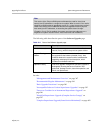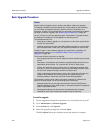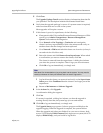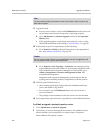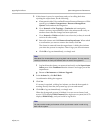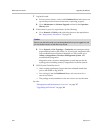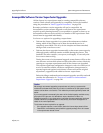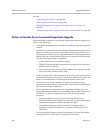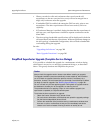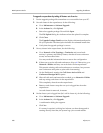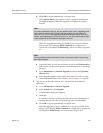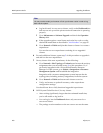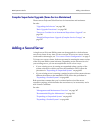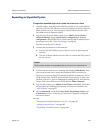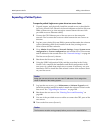
Upgrading the Software System Management and Maintenance
Polycom, Inc. 397
• History records for calls and conferences that cross from the old
supercluster to the new one (and vice versa) will not be merged into a
single call/conference after the upgrade.
• If embedded DNS is enabled, the enterprise DNS can only point to one
supercluster. The other supercluster will not have territory fail-over
capability.
• If Conference Manager is enabled, during the time that the supercluster is
split into two, each supercluster could host separate conferences on the
same VMR.
• The site topology bandwidth specifications will be duplicated in both the
old supercluster and the new supercluster. Without significant changes to
the site topology’s bandwidth configuration, this can lead to bandwidth
overloading during the upgrade.
See also:
“Upgrading the Software” on page 388
“Basic Upgrade Procedures” on page 390
Simplified Supercluster Upgrade (Complete Service Outage)
If it’s possible to schedule the upgrade for a maintenance window during
which there is no service, we strongly recommend doing so, as described
below. This greatly shortens and simplifies the process.
Caution
Always check the upgrade version release notes before installing an upgrade.
The upgrade installation process automatically creates a backup, which enables
you to roll back an upgrade (restore the previous version) if necessary. As a
precaution, however, we recommend that you download a recent backup file before
you begin to install an upgrade. See “Backing Up and Restoring” on page 381.
You can roll back only the last applied upgrade. Rolling back an upgrade restores
the database to its state prior to the upgrade, so data may be lost.
The procedure below is for applying a major or minor software upgrade (not
supercluster-compatible) to a superclustered system.
To minimize the time required for an upgrade:
• Obtain the license activation key(s) ahead of time.
• On each cluster, download a recent backup and upload the upgrade package
file (the first two steps below) ahead of time.
• Perform the remainder of the procedure during a maintenance window when
there are no calls or conferences so that you can immediately take all the
clusters out of service instead of having to wait for all activity to end.



